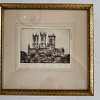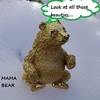Posted 1 year ago
 glasfreund
glasfreund
(38 items)
Sometimes we find it difficult to find the correct color designation of a Lötz glass. For example, it is not always easy to tell the difference between green, ordinary green, anna green, yellow green, imperial green, Russian green, jade green, stone green - and this is just a selection of all the “greens”. And then there are creta, olympia, diana and other colors that refer to a shade of green. The thickness of a color layer, the thickness of the glass, a possible additional glass layer, and the iridescence influence the color effect, as does the light that reflects the color. When we only have photos of an object, it is sometimes impossible to recognize the color correctly. The color then depends not only on the light in which the glass was photographed, but also on the image processing.
Lötz can even mislead us with some of the color designations. The jardiniere with the applied leafs glows an intense green in sunlight. The strong fluorescence in UV light confirms the coloration with uranium oxides. In artificial light, we see only a pale green. Lötz, however, describes this color as “gelb” (yellow). In the case of the jardiniere, we find the corresponding description “gelb gerippt mit candia Silberiris” (yellow ribbed with candia silver iris) in the pattern entries. When searching for other decorations in “gelb” (yellow), we quickly find the following: “Empire gelb Texas”, "gelb Boulé-Boulé”, “gelb Coppelia”, etc. These glasses are probably all colored with uranium oxides.
The color designation “weiss” (white) can cause similar confusion. We find it in the same decors such as “Coppelia weiss” and “weiss Boulé-Boulé”. These glasses are not white, but colourless and iridescent. The iridescence could be the reason why they are not called “cristall”.
To the pictures from left to right: The jardiniere PN II-4772 in artificial light and in black light. A tubular vase in the same coloring (PN II-3316: “gelb gerippt mit candia Silberfuss & Blätter”). Large vase “weiss Boulé-Boulé”, PN II-2135).
































A color designation I always find perplexing are the reds...apparently Lotz saw what I would call "orange" as red, and what I call "red" as orange. Imperial red being a color we see in common, lol!
It would be interesting to find out what Lötz used to determine the color names. Sometimes I think that the color of the purchased (?) colored glass, the glass powder or the glass frit could have played a role. But that is purely speculative. A glassmaker would certainly be able to give us a few tips...
glasfreund , Interesting, I am also curious of the gelb colours.
I am searching for info about Beyermann&Company, Haida. Recently I received a photo of a paper pattern drawing with their name on, DEK 11-1967. There is mentioned Marongelb.
glasfreund; Sorry, not DEK...that is something else. I am not good at reading the texts. Trying to learn to decipher what is meant...